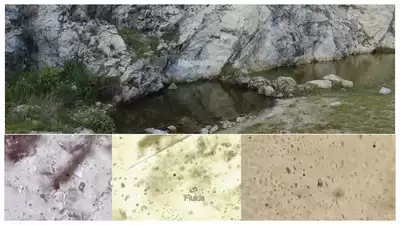Unveiling Earth's Ancient Secrets: Indian and Japanese Scientists Uncover 600-Million-Year-Old Ocean Water Hidden within the Majestic Himalayas!
In a groundbreaking discovery, a collaborative effort by Indian and Japanese scientists has unveiled the existence of water droplets trapped within mineral deposits believed to originate from an ancient ocean that thrived around 600 million years ago. This remarkable finding, made by researchers from the Indian Institute of Science (IISc) and Niigata University, Japan, holds the potential to unlock valuable insights into the ancient ocean's conditions, including pH levels, chemistry, and isotopic composition. Previously only hypothesized or modeled, this newfound information could provide essential clues about the evolution of Earth's oceans and even shed light on the history of life on our planet.
Delving into the composition of the deposits, which contained both calcium and magnesium carbonates, the scientific team also offered a plausible explanation for a significant event in Earth's past – the Second Great Oxygenation Event. This pivotal occurrence followed the Snowball Earth glaciation, an epoch between 700 and 500 million years ago marked by extensive ice coverage on the planet. As the glaciers receded, there was a surge in atmospheric oxygen levels, paving the way for the development of complex life forms.
The journey leading to this discovery has been ongoing for five years, with the joint research team from IISc and Niigata University focusing on the tectonic evolution of the Himalayan and Nagaland belt. Three researchers from IISc, along with their Japanese counterparts, played instrumental roles in making this breakthrough. Sajeev Krishnan, a professor at the Centre for Earth Sciences (CEaS), IISc, and the study's corresponding author, expressed that this discovery opens up significant possibilities for further research on these rocks and their enclosed fluids. Moreover, the findings have broader implications for unraveling Earth's tectonic history.
The absence of well-preserved fossils and the disappearance of past oceans have hindered scientists from fully understanding the connection between the glaciation and the oxygenation event. Nevertheless, the marine rocks exposed in the Himalayas offer a glimpse into the past and act as a precious "time capsule" for studying ancient oceans. Prakash Chandra Arya, a PhD student at CEaS, IISc, and the first author of the published study in Precambrian Research, emphasized the potential significance of these insights. Learning about the past oceans' characteristics – their acidity, nutrient content, temperature, and chemical composition – could contribute valuable data for climate modeling and aid in understanding Earth's climatic history.
The deprivation of calcium during the Snowball Earth glaciation likely caused a nutrient deficiency, creating a suitable environment for slow-growing photosynthetic cyanobacteria. These cyanobacteria, through their photosynthetic processes, would have released more oxygen into the atmosphere as calcium levels decreased, contributing to the overall rise in oxygen levels and initiating biological radiation or evolution.
The dedicated team searched extensively across the western Kumaon Himalayas, from Amritpur to the Milam glacier, and from Dehradun to the Gangotri glacier region, to find these vital mineral deposits. Rigorous laboratory analyses confirmed that the deposits indeed originated from precipitation within ancient ocean water, rather than from volcanic activities within the Earth's interior.
Notably, the sedimentary basins where the deposits were found lacked calcium input for an extended period, likely due to low riverine flow during that time. As a result, more magnesium precipitated, forming the deposits that later trapped the paleo ocean water within their crystalline structures.
This fascinating discovery marks a significant milestone in our understanding of Earth's ancient history. With each droplet of water enclosed in magnesite crystals, scientists gain a window into a world that existed millions of years ago, offering tantalizing clues about the mysteries of the past and the forces that have shaped our planet's evolution. The implications of this research are far-reaching, opening up new avenues of exploration and enriching our knowledge of the Earth's complex and dynamic past.








No comments
Thanks For Visiting